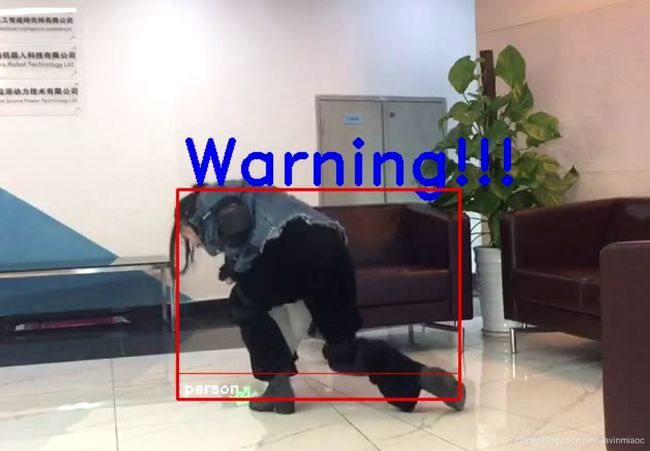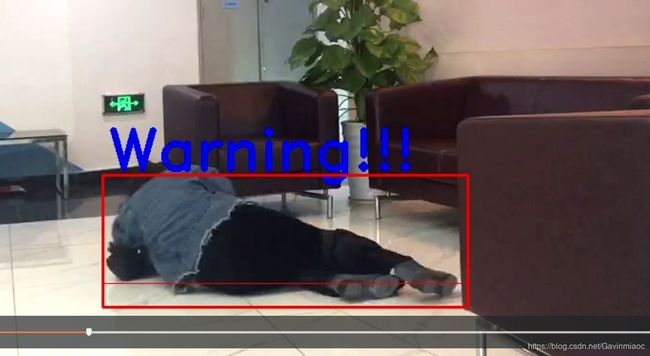基于YOLOv3+Kalman-Filter实现Multi-target tracking
本文以kears-yolov3做detector,以Kalman-Filter算法做tracker,进行多人物目标追踪,其应用常见于客流量统计,行人追踪检测,可延伸至Fall Detection,Loitering Detection徘徊检测等项目。
自有数据集上,如何用keras最简单训练YOLOv3目标检测
应用举例:
这个可以看做多目标跟踪任务,图中追踪到三个行人,记录在视频左上方数字3.其他被检测到的物体不参与数字统计。
其实是一种比较简单的多目标追踪方式:detector+tracker,两者其实是相对独立的。 另外可以支持应用算法扩展,比如添加跌倒,徘徊,轨迹计算等算法。
这里的流程就是,图片经过detector,得到人体坐标框,然后计算中心点位置centers(x0,y0),将该centers(x0,y0)输入给追踪器,追踪器去学习(Update)并给出预测。 其中每一帧的图,tracker都会给出多条轨迹,每条轨迹都可能由若干个点组成:
来看一下常规的update里面发生了什么?(简单贴一下)
# 第一段
cost = np.zeros(shape=(N, M)) # Cost matrix
for i in range(len(self.tracks)):
for j in range(len(detections)):
try:
diff = self.tracks[i].prediction - detections[j]
distance = np.sqrt(diff[0][0]*diff[0][0] +
diff[1][0]*diff[1][0])
cost[i][j] = distance
except:
pass
# 第二段
row_ind, col_ind = linear_sum_assignment(cost)
新的一帧物体中心点centers给入之后,tracker与给出预测值prediction ,同时预测值与实际detections的距离去迭代匈牙利算法匹配(linear_sum_assignment)。
当然这套算法好处是在,可以任意组合比较好的detector/tracker算法,项目Smorodov/Multitarget-tracker中就是Opencv中的 face detector + Kalman filter multitarget tracker。 笔者引用的是项目:srianant/kalman_filter_multi_object_tracking中的KF算法。
项目准备:
1.环境配置:tensorflow-gpu 1.2.1 + python 3.5 +
2.YOLOV3: (Real-time Multi-person tracker using YOLO v3 and deep_sort with tensorflow)
Download YOLOv3 or tiny_yolov3 weights from YOLO website.Then convert the Darknet YOLO model to a Keras model.
python3 convert.py yolov3.cfg yolov3.weights model_data/yolo.h5那么在model_data文件夹下得到yolo.h5,这正是我们需要的keras model.详见源码3
笔者也提供一下转化之后的h5文件。
链接:https://pan.baidu.com/s/1ppQH_FEbYSHob2T7NQOVmg 提取码:e345
步骤为:
- 根据yolov3跑出结果
yolo_test.detect_image - 计算人物框的中心点
calc_center - 更新tracker,
trackerDetection
再来看看tracker里面的属性:
self.track_id = trackIdCount # identification of each track object
self.KF = KalmanFilter() # KF instance to track this object
self.prediction = np.asarray(prediction) # predicted centroids (x,y)
self.skipped_frames = 0 # number of frames skipped undetected
self.trace = [] # trace path
track_id每个追踪物体的标识;prediction预测下一个点;trace轨迹点。
>>> tracker.tracks[0].trace
>>>[array([[116.],
[491.]]), array([[135.],
[570.]]), array([[142.],
[597.]])]
>>>tracker.tracks[0].track_id
>>>100
>>>tracker.tracks[0].prediction
>>>array([[116.],
[491.]])详见源码1. 效果如开篇上图。
核心代码:
# -*- coding: utf-8 -*-
# 可用于客流量统计,行人检测跟踪
#from tracker import Tracker
import copy
import colorsys
import os,sys,argparse,random,time
project = 'keras-yolov3-KF-objectTracking' # 工作项目根目录
sys.path.append(os.getcwd().split(project)[0] + project)
from timeit import default_timer as timer
import cv2
import numpy as np
from keras import backend as K
from keras.models import load_model
from keras.layers import Input
from PIL import Image, ImageFont, ImageDraw
from yolo3.model import yolo_eval, yolo_body, tiny_yolo_body
from yolo3.utils import letterbox_image
from keras.utils import multi_gpu_model
from yolo_matt import YOLO, detect_video
from tqdm import tqdm
from scipy import misc
from objecttracker.KalmanFilterTracker import Tracker # 加载卡尔曼滤波函数
def calc_center(out_boxes,out_classes,out_scores,score_limit = 0.5):
outboxes_filter = []
for x,y,z in zip(out_boxes,out_classes,out_scores):
if z > score_limit:
if y == 0: # 0:person ,coco_classes.txt
outboxes_filter.append(x)
centers= []
number = len(outboxes_filter)
for box in outboxes_filter:
top, left, bottom, right = box
center=np.array([[(left+right)//2],[(top+bottom)//2]])
centers.append(center)
return centers,number
def get_colors_for_classes(num_classes):
"""Return list of random colors for number of classes given."""
# Use previously generated colors if num_classes is the same.
if (hasattr(get_colors_for_classes, "colors") and
len(get_colors_for_classes.colors) == num_classes):
return get_colors_for_classes.colors
hsv_tuples = [(x / num_classes, 1., 1.) for x in range(num_classes)]
colors = list(map(lambda x: colorsys.hsv_to_rgb(*x), hsv_tuples))
colors = list(
map(lambda x: (int(x[0] * 255), int(x[1] * 255), int(x[2] * 255)),
colors))
#colors = [(255,99,71) if c==(255,0,0) else c for c in colors ] # 单独修正颜色,可去除
random.seed(10101) # Fixed seed for consistent colors across runs.
random.shuffle(colors) # Shuffle colors to decorrelate adjacent classes.
random.seed(None) # Reset seed to default.
get_colors_for_classes.colors = colors # Save colors for future calls.
return colors
def trackerDetection(tracker,image,centers,number,max_point_distance = 30,max_colors = 20,track_id_size = 0.8):
'''
- max_point_distance为两个点之间的欧式距离不能超过30
- 有多条轨迹,tracker.tracks;
- 每条轨迹有多个点,tracker.tracks[i].trace
- max_colors,最大颜色数量
- track_id_size,每个
'''
#track_colors = [(255, 0, 0), (0, 255, 0), (0, 0, 255), (255, 255, 0),
# (0, 255, 255), (255, 0, 255), (255, 127, 255),
# (127, 0, 255), (127, 0, 127)]
track_colors = get_colors_for_classes(max_colors)
result = np.asarray(image)
font = cv2.FONT_HERSHEY_SIMPLEX
cv2.putText(result, str(number), (20, 40), font, 1, (0, 0, 255), 5) # 左上角,人数计数
if (len(centers) > 0):
# Track object using Kalman Filter
tracker.Update(centers)
# For identified object tracks draw tracking line
# Use various colors to indicate different track_id
for i in range(len(tracker.tracks)):
# 多个轨迹
if (len(tracker.tracks[i].trace) > 1):
x0,y0 = tracker.tracks[i].trace[-1][0][0],tracker.tracks[i].trace[-1][1][0]
cv2.putText(result,str(tracker.tracks[i].track_id),(int(x0),int(y0)),font,track_id_size,(255, 255, 255),4)
# (image,text,(x,y),font,size,color,粗细)
for j in range(len(tracker.tracks[i].trace) - 1):
#每条轨迹的每个点
# Draw trace line
x1 = tracker.tracks[i].trace[j][0][0]
y1 = tracker.tracks[i].trace[j][1][0]
x2 = tracker.tracks[i].trace[j + 1][0][0]
y2 = tracker.tracks[i].trace[j + 1][1][0]
clr = tracker.tracks[i].track_id % 9
distance = ((x2 - x1)** 2 + (y2 - y1)**2)**0.5
if distance < max_point_distance:
cv2.line(result, (int(x1), int(y1)), (int(x2), int(y2)),
track_colors[clr], 4)
return tracker,result
def main(yolo_test):
# Definition of the parameters
path = "video_demo/tracking.avi"
tracker = Tracker(100, 8, 15, 100)
writeVideo_flag = True
cap = cv2.VideoCapture(path) # path
n = 0
if writeVideo_flag:
# Define the codec and create VideoWriter object
w = int(cap.get(cv2.CAP_PROP_FRAME_WIDTH))
h = int(cap.get(cv2.CAP_PROP_FRAME_HEIGHT))
fourcc = cv2.VideoWriter_fourcc(*'MJPG')
out = cv2.VideoWriter('output.avi', fourcc, 15, (w, h))
fps = 0.0
while True:
ret, frame = cap.read() # frame shape 640*480*3
if ret != True:
break
t1 = time.time()
image = Image.fromarray(frame)
r_image, out_boxes, out_scores, out_classes = yolo_test.detect_image(image)
print("box_num:",len(out_boxes))
#print(out_classes)
centers, number = calc_center(out_boxes, out_classes, out_scores, score_limit=0.6)
tracker, result = trackerDetection(tracker, r_image, centers, number, max_point_distance=20)
cv2.imshow('', result)
if writeVideo_flag:
# save a frame
out.write(result)
fps = (fps + (1. / (time.time() - t1))) / 2
print("fps= %f" % (fps))
# Press Q to stop!
if cv2.waitKey(1) & 0xFF == ord('q'):
break
print('Down!')
cap.release()
if writeVideo_flag:
out.release()
cv2.destroyAllWindows()
if __name__ == '__main__':
# 加载keras yolov3 voc预训练模型
yolo_test_args = {
"model_path": 'model_data/yolo.h5',
"anchors_path": 'model_data/yolo_anchors.txt',
"classes_path": 'model_data/coco_classes.txt',
"score" : 0.3,
"iou" : 0.45,
"model_image_size" : (416, 416),
"gpu_num" : 1,
}
yolo_test = YOLO(**yolo_test_args)
main(yolo_test)
'''
解析方式一: 从视频保存成的图像文件中进行解析
先把视频-> 拆分成图像文件夹,在文件夹中逐帧解析
tracker = Tracker(100, 8, 15, 100)
for n in tqdm(range(100)):
image = Image.open('video_demo/video2jpg1/%s.jpg'%n)
r_image,out_boxes, out_scores, out_classes = yolo_test.detect_image(image)
centers,number = calc_center(out_boxes,out_classes,out_scores,score_limit = 0.5)
tracker,result = trackerDetection(tracker,r_image,centers,number)
misc.imsave('video_demo/jpg2video/%s.jpg'%n, result)
'''
'''
解析方式二:视频流直接解析
直接读取视频流,并保存在某一个文件夹之中
# 视频 -> 图像
path = "video_demo/tracking.avi"
tracker = Tracker(100, 8, 15, 100)
cap = cv2.VideoCapture(path)
n = 0
while(True):
ret, frame = cap.read()
if frame is None:
break
image = Image.fromarray(frame )
r_image,out_boxes, out_scores, out_classes = yolo_test.detect_image(image)
centers,number = calc_center(out_boxes,out_classes,out_scores,score_limit = 0.6)
tracker,result = trackerDetection(tracker,r_image,centers,number,max_point_distance = 20)
#misc.imsave('unilever/grom_pic/%s.jpg'%n, result)
cv2.imwrite('video_demo/tracking/%s.jpg'%n,result, [int(cv2.IMWRITE_JPEG_QUALITY), 100] )
n += 1
print('Down!')
'''
'''
辅助函数
图像文件夹直接变为视频并保存
# 图像 -> 视频
def get_file_names(search_path):
for (dirpath, _, filenames) in os.walk(search_path):
for filename in filenames:
yield filename#os.path.join(dirpath, filename)
def save_to_video(output_path,output_video_file,frame_rate):
list_files = sorted([int(i.split('_')[-1].split('.')[0]) for i in get_file_names(output_path)])
# 拿一张图片确认宽高
img0 = cv2.imread(os.path.join(output_path,'%s.jpg'%list_files[0]))
#print(img0)
height , width , layers = img0.shape
# 视频保存初始化 VideoWriter
fourcc = cv2.VideoWriter_fourcc(*'mp4v')
videowriter = cv2.VideoWriter(output_video_file,fourcc, frame_rate, (width,height))
# 核心,保存的东西
for f in list_files:
f = '%s.jpg'%f
#print("saving..." + f)
img = cv2.imread(os.path.join(output_path, f))
videowriter.write(img)
videowriter.release()
cv2.destroyAllWindows()
print('Success save %s!'%output_video_file)
pass
# 图片变视频
output_dir='video_demo/tracking/'
output_path= os.path.join(output_dir, '') # 输入图片存放位置
output_video_file = 'video_demo/tracking_100_8_6_100_optimization_fps20.mp4' # 输入视频保存位置以及视频名称
save_to_video(output_path,output_video_file,20)
'''
接下来看看Fall-detection效果:
核心代码:
# -*- coding: utf-8 -*-
# 基于yolov3的行人跌倒检测 by gavin
import colorsys
import os, sys, random, time
import cv2
import numpy as np
from PIL import Image, ImageFont, ImageDraw
from yolo_matt import YOLO, detect_video
from objecttracker.KalmanFilterTracker import Tracker # 加载卡尔曼滤波函数
def calc_center(out_boxes, out_classes, out_scores, score_limit=0.5):
outboxes_filter = []
for x, y, z in zip(out_boxes, out_classes, out_scores):
if z > score_limit:
if y == 0:
outboxes_filter.append(x)
centers = []
number = len(outboxes_filter)
for box in outboxes_filter:
top, left, bottom, right = box
center = np.array([[(left + right) // 2], [(top + bottom) // 2]])
centers.append(center)
return centers, number
def get_colors_for_classes(num_classes):
"""Return list of random colors for number of classes given."""
# Use previously generated colors if num_classes is the same.
if (hasattr(get_colors_for_classes, "colors") and
len(get_colors_for_classes.colors) == num_classes):
return get_colors_for_classes.colors
hsv_tuples = [(x / num_classes, 1., 1.) for x in range(num_classes)]
colors = list(map(lambda x: colorsys.hsv_to_rgb(*x), hsv_tuples))
colors = list(
map(lambda x: (int(x[0] * 255), int(x[1] * 255), int(x[2] * 255)),
colors))
# colors = [(255,99,71) if c==(255,0,0) else c for c in colors ] # 单独修正颜色,可去除
random.seed(10101) # Fixed seed for consistent colors across runs.
random.shuffle(colors) # Shuffle colors to decorrelate adjacent classes.
random.seed(None) # Reset seed to default.
get_colors_for_classes.colors = colors # Save colors for future calls.
return colors
def trackerDetection(tracker, image, centers, number, max_point_distance=30, max_colors=20, track_id_size=0.8):
'''
- max_point_distance为两个点之间的欧式距离不能超过30
- 有多条轨迹,tracker.tracks;
- 每条轨迹有多个点,tracker.tracks[i].trace
- max_colors,最大颜色数量
- track_id_size,每个
'''
# track_colors = [(255, 0, 0), (0, 255, 0), (0, 0, 255), (255, 255, 0),
# (0, 255, 255), (255, 0, 255), (255, 127, 255),
# (127, 0, 255), (127, 0, 127)]
track_colors = get_colors_for_classes(max_colors)
result = np.asarray(image)
font = cv2.FONT_HERSHEY_SIMPLEX
cv2.putText(result, str(number), (20, 40), font, 1, (0, 0, 255), 5) # 左上角,人数计数
if (len(centers) > 0):
# Track object using Kalman Filter
tracker.Update(centers)
# For identified object tracks draw tracking line
# Use various colors to indicate different track_id
for i in range(len(tracker.tracks)):
# 多个轨迹
if (len(tracker.tracks[i].trace) > 1):
x0, y0 = tracker.tracks[i].trace[-1][0][0], tracker.tracks[i].trace[-1][1][0]
cv2.putText(result, str(tracker.tracks[i].track_id), (int(x0), int(y0)), font, track_id_size,
(255, 255, 255), 4)
# (image,text,(x,y),font,size,color,粗细)
for j in range(len(tracker.tracks[i].trace) - 1):
# 每条轨迹的每个点
# Draw trace line
x1 = tracker.tracks[i].trace[j][0][0]
y1 = tracker.tracks[i].trace[j][1][0]
x2 = tracker.tracks[i].trace[j + 1][0][0]
y2 = tracker.tracks[i].trace[j + 1][1][0]
clr = tracker.tracks[i].track_id % 9
distance = ((x2 - x1) ** 2 + (y2 - y1) ** 2) ** 0.5
if distance < max_point_distance:
cv2.line(result, (int(x1), int(y1)), (int(x2), int(y2)),
track_colors[clr], 4)
return tracker, result
def isFall(w, h):
if float(w) / h >= 0.9:# 1.1
return True
else:
return False
def main(yolo_test):
# Definition of the parameters
path = 'video_demo/cs4.mp4' # "video_demo/tracking.avi", 'video_demo/cs4.mp4' 'video_demo/faint7.avi'
tracker = Tracker(100, 8, 15, 100)
writeVideo_flag = True
# begin:open the input video file
input_movie = cv2.VideoCapture(path) # 'cs4.mp4' faint7.avi
length = int(input_movie.get(cv2.CAP_PROP_FRAME_COUNT))
# Create an output movie file (make sure resolution/frame rate matches input video!)
# get fps the size
fps = input_movie.get(cv2.CAP_PROP_FPS)
size = (int(input_movie.get(cv2.CAP_PROP_FRAME_WIDTH)),
int(input_movie.get(cv2.CAP_PROP_FRAME_HEIGHT)))
# define the type of the output movie
output_movie = cv2.VideoWriter('out_fall_detect.avi', cv2.VideoWriter_fourcc(*'MJPG'), fps, size)
res = []
frame_number = 0
while True:
# Grab a single frame of video
ret, frame = input_movie.read()
frame_number += 1
# Quit when the input video file ends
if not ret:
break
'''
# detect per 2 frame
if frame_number%2==0:
continue
'''
# append all the coordinate of the detected person to res
image = Image.fromarray(frame)
start = time.time()
# yolov3 detector
r_image, out_boxes, out_scores, out_classes = yolo_test.detect_image(image)
print("box_num:", len(out_boxes))
centers, number = calc_center(out_boxes, out_classes, out_scores, score_limit=0.6)
# number :人数统计
tracker, result = trackerDetection(tracker, r_image, centers, number, max_point_distance=20)
# cv2.imshow('', result)
# 以下添加跌倒检测算法
res = []
for i, c in list(enumerate(out_classes)): #eg:output: [0 0 0 0 0 2 2 7]
predicted_class = yolo_test.class_names[c] # 0:person,2:car,...
box = out_boxes[i]
score = out_scores[i]
top, left, bottom, right = box
x, y = (left + right) // 2,(top + bottom) // 2
w = abs(right - left)
h = abs(bottom - top)
res.append((predicted_class, score, (x, y, w, h)))
res = sorted(res, key=lambda x: -x[1])
print('the whole running time is: ' + str(time.time() - start))
resAll = []
for item in res:
if item[0] == 'person' or item[0] == 'dog' or item[0] == 'cat' or item[0] == 'horse': # item[0] == 'dog'
resAll.append(item)
# if multiple exist, and there also contains person, preserve person only!
print('--------------')
#print(resAll)
# get the max rectangle
result = []
maxArea = 0
if len(resAll) > 1:
for item in resAll:
if item[2][2] * item[2][3] > maxArea:
maxArea = item[2][2] * item[2][3]
result = item
elif len(resAll) == 1:
result = resAll[0]
# draw the result
if (len(result) > 0):
# label the result
left = int(result[2][0] - result[2][2] / 2)
top = int(result[2][1] - result[2][3] / 2)
right = int(result[2][0] + result[2][2] / 2)
bottom = int(result[2][1] + result[2][3] / 2)
# whether fall?
if isFall(result[2][2], result[2][3]):
cv2.rectangle(frame, (left, top), (right, bottom), (0, 0, 255), 2)
# Draw a label with a name below the face
cv2.rectangle(frame, (left, bottom - 25), (right, bottom), (0, 0, 255))
font = cv2.FONT_HERSHEY_DUPLEX
cv2.putText(frame, 'Warning!!!', (left + 6, top - 6), font, 2, (255, 0, 0), 3)
else:
cv2.rectangle(frame, (left, top), (right, bottom), (255, 0, 0), 2)
# label the result
for item in resAll: # res:所有检测到的结果 ;resPerson:仅仅记录人
# Draw a box around the face
name = item[0]
left = int(item[2][0] - item[2][2] / 2)
top = int(item[2][1] - item[2][3] / 2)
right = int(item[2][0] + item[2][2] / 2)
bottom = int(item[2][1] + item[2][3] / 2)
cv2.rectangle(frame, (left, top), (right, bottom), (0, 0, 255), 2)
# Draw a label with a name below the face
cv2.rectangle(frame, (left, bottom - 25), (right, bottom), (0, 0, 255))
font = cv2.FONT_HERSHEY_DUPLEX
if name == 'person':
cv2.putText(frame, name, (left + 6, bottom - 6), font, 0.5, (255, 255, 255), 1)
# Display the result
cv2.imshow('Fall detection', frame)
# Write the resulting image to the output video file
print("Writing frame {} / {}".format(frame_number, length))
if writeVideo_flag:
# save a frame
output_movie.write(frame)
# Hit 'q' on the keyboard to quit!
if cv2.waitKey(1) & 0xFF == ord('q'):
break
# All done!
print('All done!')
input_movie.release()
if writeVideo_flag:
output_movie.release()
cv2.destroyAllWindows()
if __name__ == '__main__':
# 加载keras yolov3 voc预训练模型
yolo_test_args = {
"model_path": 'model_data/yolo.h5',
"anchors_path": 'model_data/yolo_anchors.txt',
"classes_path": 'model_data/coco_classes.txt',
"score": 0.3,
"iou": 0.45,
"model_image_size": (416, 416),
"gpu_num": 1,
}
yolo_test = YOLO(**yolo_test_args)
main(yolo_test)
源码参考1:https://github.com/mattzheng/keras-yolov3-KF-objectTracking
源码参考2:https://github.com/qiaoguan/Fall-detection
源码参考3:https://github.com/Qidian213/deep_sort_yolov3

